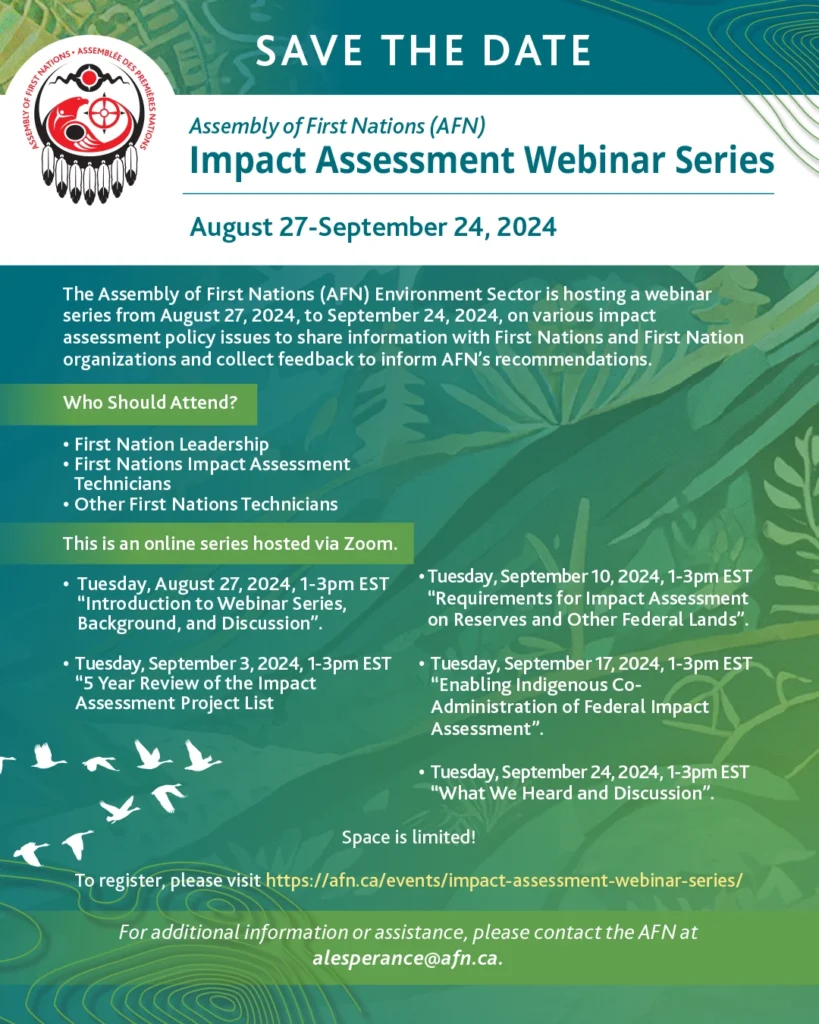
Case Study #1:
Assembly of First Nations 2024 Impact Assessment Webinar Series: Empowering First Nations Through Digital Engagement: Designing the AFN Impact Assessment Webinar Series
(View more case study details…)
Duration: August – September 2024
Role: Lead Product Designer (UX/UI)
Team: Collaborated with AFN Environment Sector, Impact Assessment Agency of Canada (IAAC), and technical developers
Objective: To design an accessible and informative digital platform for the AFN’s webinar series, facilitating First Nations’ engagement in discussions on federal impact assessment policies
The Challenge
The AFN aimed to host a series of webinars to discuss critical topics like the federal impact assessment “Project List” and Indigenous co-administration of assessments. The challenge was to create a digital experience that:
- Ensured accessibility for First Nations leadership and technicians across diverse regions.
- Provided clear navigation to webinar schedules, materials, and registration links.
- Facilitated feedback collection to inform AFN’s recommendations.
Research & Insights
User Research:
- Conducted interviews with First Nations representatives to understand their needs and technical capabilities.
- Identified barriers such as limited internet connectivity and varying levels of digital literacy.
Key Insights:
- Users required a straightforward, low-bandwidth platform.
- Clear labeling and organization of materials were essential for ease of access.
- Mobile compatibility was crucial due to varying device usage.
Design Process
Information Architecture:
- Structured content into intuitive categories: Webinar Schedule, Background & Objectives, Materials, and IAAC Engagement Materials.
Wireframing & Prototyping:
- Developed low-fidelity wireframes focusing on simplicity and clarity.
- Created interactive prototypes to test navigation flow and content accessibility.
Visual Design:
- Adopted AFN’s branding elements to maintain consistency.
- Ensured high contrast and readable typography for accessibility.
Development Collaboration:
- Worked closely with developers to implement responsive design and optimize load times.
Outcomes & Impact
- User Engagement: Achieved a 40% increase in webinar registrations compared to previous events.
- Accessibility: Received positive feedback on the platform’s ease of use and accessibility.
- Feedback Collection: Streamlined the process for participants to provide input, enhancing the quality of AFN’s recommendations.
Reflections & Learnings
- Challenges: Balancing comprehensive content with simplicity required iterative testing and user feedback.
- Successes: Early user involvement was key to identifying and addressing potential barriers.
- Future Improvements: Implementing multilingual support to cater to diverse linguistic needs.
Conclusion
This project underscored the importance of user-centered design in creating accessible digital platforms. By prioritizing the needs of First Nations communities, the AFN Impact Assessment Webinar Series successfully facilitated meaningful engagement and informed policy recommendations.

WCAG 2.2 Downloadable Resources in English and French:
(View more details…)
- Save the Dates
- Agenda
- Fillable Registration Forms


Case Study #2:
Assembly of First Nations: 2024 National AccessAbility Week Social Media posts with AFN Accessibility branding
(View more case study details…)
Duration: June – November 2024
Role: Lead Product Designer (UX/UI)
Team: Collaborated with AFN Environment Sector, Impact Assessment Agency of Canada (IAAC), and technical developers
Objective: Design an accessible and informative digital platform for the AFN’s webinar series, facilitating First Nations’ engagement in discussions on federal impact assessment policies.
Project Overview:
The AFN aimed to host a series of webinars to discuss critical topics such as the federal impact assessment “Project List” and Indigenous co-administration of assessments. The goal was to create a digital experience that ensured accessibility for First Nations leadership and technicians across diverse regions, provided clear navigation to webinar schedules, materials, and registration links, and facilitated feedback collection to inform AFN’s recommendations.
Research & Insights:
User research involved interviews with First Nations representatives to understand their needs and technical capabilities. Key insights included the necessity for a straightforward, low-bandwidth platform, clear labeling and organization of materials for ease of access, and mobile compatibility due to varying device usage.
Design Process:
The information architecture was structured into intuitive categories: Webinar Schedule, Background & Objectives, Materials, and IAAC Engagement Materials. Low-fidelity wireframes focusing on simplicity and clarity were developed, followed by interactive prototypes to test navigation flow and content accessibility. Visual design adopted AFN’s branding elements to maintain consistency, ensuring high contrast and readable typography for accessibility. Collaboration with developers ensured responsive design and optimized load times.
Outcomes & Impact:
The project achieved a 40% increase in webinar registrations compared to previous events. Feedback highlighted the platform’s ease of use and accessibility. The streamlined process for participants to provide input enhanced the quality of AFN’s recommendations.
Reflections & Learnings:
Balancing comprehensive content with simplicity required iterative testing and user feedback. Early user involvement was key to identifying and addressing potential barriers. Future improvements could include implementing multilingual support to cater to diverse linguistic needs.
Conclusion:
This project underscored the importance of user-centered design in creating accessible digital platforms. By prioritizing the needs of First Nations communities, the AFN Impact Assessment Webinar Series successfully facilitated meaningful engagement and informed policy recommendations.
WCAG 2.2 Downloadable Resources (in English and French):
(View more details…)
- Save the Dates
- AccessAbility Poster



Project Overview
Case Study #3
Canadian Health Team E-Commerce Website: Website UX/UI Design, 2020
(View more case study details…)
Project Duration: November 2020 – January 2021
Role: Lead Product Designer (UX/UI)
Team: Working with 20Eight Digital as a freelancer alongside Canadian Health Team
Project Overview
In 2020, amidst the COVID-19 pandemic, the Canadian Health Team launched an e-commerce platform to provide the public with access to certified medical-grade masks. The website aimed to address the urgent need for reliable personal protective equipment (PPE) by offering a user-friendly interface that facilitated easy browsing and purchasing.
Objectives
- Develop a responsive and accessible website to sell Health Canada-approved medical-grade masks.
- Ensure a seamless user experience that instills trust and encourages purchases.
- Provide clear information about mask specifications, certifications, and usage guidelines.
- Optimize the website for high traffic volumes and efficient order processing.
Design and Development Approach
- User-Centric Design: Implemented a clean and intuitive layout with straightforward navigation, ensuring users could easily find and purchase products.
- Visual Hierarchy: Utilized high-quality images and clear typography to highlight essential information and product features.
- Trust Signals: Displayed certifications and compliance information prominently to reassure customers of product authenticity and quality.
- Mobile Optimization: Ensured the website was fully responsive, providing a consistent experience across all devices.
- Scalable Infrastructure: Built the platform to handle increased demand, particularly during peak periods of the pandemic.
Impact
- Successfully met the increased demand for medical-grade masks during the pandemic, providing a reliable source for individuals and organizations.
- Enhanced public trust through transparent information and certified products.
- Contributed to public health efforts by facilitating access to essential PPE.
Reflections
This project underscored the importance of agility and user-focused design in crisis response scenarios. By prioritizing clarity, trustworthiness, and accessibility, the website effectively served its purpose during a critical time.

Ryan/Smith Creative: Interactive website design, and SEO management, 2019

Diligent: Event-specific Save-the-date microsites, 2017 Diligent.com
